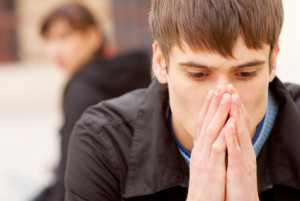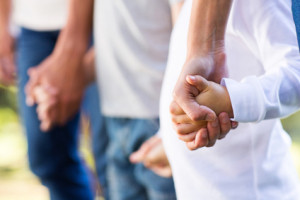- Calls to this hotline are currently being directed to Within Health or Eating Disorder Solutions
- Representatives are standing by 24/7 to help answer your questions
- All calls are confidential and HIPAA compliant
- There is no obligation or cost to call
- Eating Disorder Hope does not receive any commissions or fees dependent upon which provider you select
- Additional treatment providers are located on our directory or samhsa.gov
Adolescent Boys and Body Image
Contributor: Authored by Dr. Gregory Jantz, founder of The Center • A Place of HOPE and author of 30 books.

This out-of-synch shifting during the adolescent years causes many teenagers to feel left out, left behind, and out of place.
As a society, we are relatively familiar with the pressures felt by adolescent females. The over-abundance of thin yet perfectly curvy (photo-shopped) pictures of celebrities and supermodels set unrealistic standards for young girls. Young men, however, are also increasing burdened with social pressures causing negative body image and low self-esteem.
Body Image Issues Are Rising in Boys
In fact, the issue of adolescent boys and body image is currently on the rise. Within the last fifteen years, unrealistic images of bare-chested men with chiseled abs and muscles are becoming the norm in advertisements and pop culture photos.
Similar to the treatment of the female body, these advertisements and celebrity photos of men are also being photo-shopped to digitally enhance these often-unattainable “masculine” features. Furthermore, the increase of cell phone use, social media and photo sharing platforms like Instagram and Snapchat have created an interactive forum for young men to be even more bombarded what society deems as the “masculine ideal.”
How Boys Are Concerned About Body Image

A recent study by JAMA Pediatrics1 studied a large sampling of boys between the ages of 12 and 18. This study reveals that nearly 18 percent of the boys were highly concerned about their weight, physique, and masculinity. Among this 18 percent, many of the boys turned to supplements, growth hormone derivatives, or anabolic steroids to achieve their desired physique. Some of these boys also had developed unhealthy habits of disordered eating such as anorexia, bulimia, and binge eating.
Many Men Are Missing a Diagnosis
Many health professionals and organizations estimate that 1 in every 10 individuals2 that are diagnosed with an eating disorder is male. However, most of these health professionals and organizations also agree that these numbers don’t necessarily provide an accurate count of men with eating disorders, because many of the men are never professionally diagnosed.
This lack of diagnoses is most likely due to a false perception that eating disorders are female-only issues, and consequently many men either do not recognize the symptoms themselves or feel uncomfortable seeking treatment. A newer study estimates3 that approximately 1 in every 4 eating disorder suffers is male.
The Additional Risks Beyond an Eating Disorder

The adolescent years for both genders are formative. As technology and societal pressures continue to shift and intensify, it’s critical that the dialog, awareness, and support related to healthy body image for adolescent boys stay active and strong.
About the Author:
Authored by Dr. Gregory Jantz, founder of The Center • A Place of HOPE and author of 30 books. Pioneering whole-person care nearly 30 years ago, Dr. Jantz has dedicated his life’s work to creating possibilities for others, and helping people change their lives for good. The Center • A Place of HOPE, located on the Puget Sound in Edmonds, Washington, creates individualized programs to treat behavioral and mental health issues, including eating disorders, addiction, depression, anxiety and others.
Community Discussion – Share your thoughts here!
In what ways have you been supported or have you supported other adolescent boys in regards to body image?
References:
- http://archpedi.jamanetwork.com/article.aspx?articleid=1766495
- https://www.nationaleatingdisorders.org/research-males-and-eating-disorders
- https://www.ncbi.nlm.nih.gov/pmc/articles/PMC1892232/?report=reader
- https://www.aplaceofhope.com/shop/books/hope-help-healing-for-eating-disorders/
Last Updated & Reviewed By: Jacquelyn Ekern, MS, LPC on June 19th, 2015
Published on EatingDisorderHope.com
